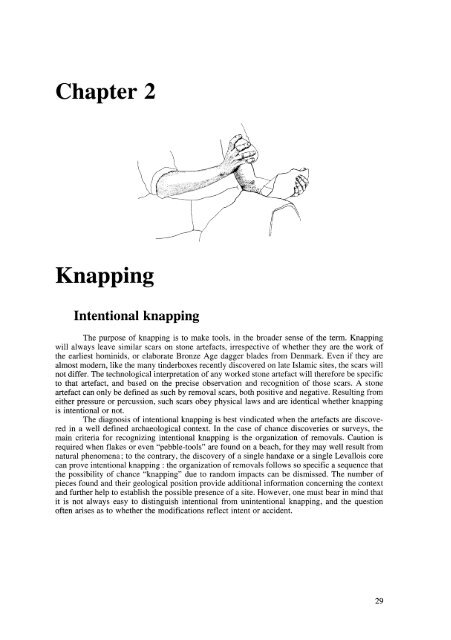Technology and Terminology of Knapped Stone - IRIT
Technology and Terminology of Knapped Stone - IRIT
Technology and Terminology of Knapped Stone - IRIT
Create successful ePaper yourself
Turn your PDF publications into a flip-book with our unique Google optimized e-Paper software.
Chapter 2<br />
Knapping<br />
Intentional knappin g<br />
The purpose <strong>of</strong> knapping is to make tools, in the broader sense <strong>of</strong> the term. Knapping<br />
will always leave similar scars on stone artefacts, irrespective <strong>of</strong> whether they are the work <strong>of</strong><br />
the earliest hominids, or elaborate Bronze Age dagger blades from Denmark. Even if they are<br />
almost modern, like the many tinderboxes recently discovered on late Islamic sites, the scars will<br />
not differ. The technological interpretation <strong>of</strong> any worked stone artefact will therefore be specific<br />
to that artefact, <strong>and</strong> based on the precise observation <strong>and</strong> recognition <strong>of</strong> those scars. A stone<br />
artefact can only be defined as such by removal scars, both positive <strong>and</strong> negative. Resulting from<br />
either pressure or percussion, such scars obey physical laws <strong>and</strong> are identical whether knapping<br />
is intentional or not.<br />
The diagnosis <strong>of</strong> intentional knapping is best vindicated when the artefacts are discovered<br />
in a well defined archaeological context. In the case <strong>of</strong> chance discoveries or surveys, the<br />
main criteria for recognizing intentional knapping is the organization <strong>of</strong> removals. Caution is<br />
required when flakes or even "pebble-tools" are found on a beach, for they may well result from<br />
natural phenomena; to the contrary, the discovery <strong>of</strong> a single h<strong>and</strong>axe or a single Levallois core<br />
can prove intentional knapping : the organization <strong>of</strong> removals follows so specific a sequence that<br />
the possibility <strong>of</strong> chance "knapping" due to r<strong>and</strong>om impacts can be dismissed. The number <strong>of</strong><br />
pieces found <strong>and</strong> their geological position provide additional information concerning the context<br />
<strong>and</strong> further help to establish the possible presence <strong>of</strong> a site. However, one must bear in mind that<br />
it is not always easy to distinguish intentional from unintentional knapping, <strong>and</strong> the question<br />
<strong>of</strong>ten arises as to whether the modifications reflect intent or accident.<br />
29

















